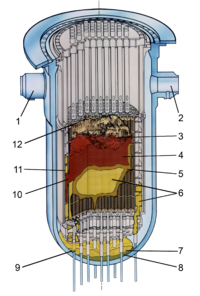
Photo from wikipedia
Abstract Dissolution of uranium dioxide by molten zircaloy at high temperatures is an important chemical process affecting the fuel melting during nuclear reactor severe accidents. In this study, the dissolution… Click to show full abstract
Abstract Dissolution of uranium dioxide by molten zircaloy at high temperatures is an important chemical process affecting the fuel melting during nuclear reactor severe accidents. In this study, the dissolution model, based on the mass transfer model and the dissolution criteria, was developed and incorporated into the Moving Particle Semi-implicit (MPS) method. To verify the dissolution model, the one-dimensional mass transfer between two semi-infinite materials was simulated by the improved MPS code. The sensitivity analyses of the particle size have been conducted since particle size determines the simulation accuracy. Then analyses on dissolution of UO 2 by molten zircaloy were performed according to results by the improved MPS code. In this study, two series of experiments on dissolution of UO 2 by molten zircaloy conducted by Kim and Olander were simulated respectively. The first series of experiments focuses on mass transfer. The corresponding simulation results of MPS show that the dissolution kinetics of UO 2 by molten zircaloy follows the parabolic law, and the penetration depths of chemical elements (U, O, Zr) were limited by time. The second series of experiments concerns on natural convection. The simulation results show that the natural convection of melting process has a significant influence on the dissolution behavior. The results indicate that the dissolution of UO 2 by molten zircaloy fits the parabolic law before the concentration of UO 2 in the liquid reaches the saturation point. After the concentration of UO 2 reaches the saturation point, the dissolution of UO 2 by molten zircaloy also obeys the parabolic law. The difference between the two parabolic laws is the dissolution rate. The dissolution rate decreases after the UO 2 is saturated in the liquid. For natural convection, the penetration depths of chemical elements (U and O) become deeper, which could accelerate the progress of dissolution.
Journal Title: Progress in Nuclear Energy
Year Published: 2017
Link to full text (if available)
Share on Social Media: Sign Up to like & get
recommendations!